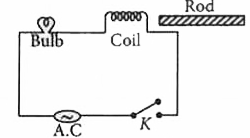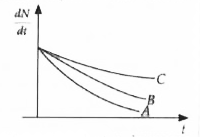In Young's double slit experiment , two wavelengths λ1=780nm and λ2=520 nm are used to obtain interference fringes. If the nth bright band due to λ1 coincides with (n+1)th bright band due to λ2, then the value of n is Solution in Kannada
4
3
2
6
The correct Answer is:C
As nth bright band due to λ1 coincides with (n+1)th bright band due to λ2
or nλ1=(n+1)λ2
or nn+1=λ2λ1=520nm780nm=23
or 3n=2n+2 or 3n−2n=2 or n=2
Topper's Solved these Questions
Similar Questions
In the A. C. circuit shown, keeping 'K' pressed, if an iron rod is inserted into the coil, the bulb in the circuit
 03:06View Solution
03:06View SolutionWhich one of the following nuclei has shorter mean life?
 01:51View Solution
01:51View SolutionIn Young's experiment the wavelength of red light is 7.5xx10^(-5) cm.and that of blue light 5.0xx10^(-5) .The value of n for which (n+1)^(th) the blue bright band coincides with n^(th) red band is -
03:09View SolutionIn young's double slit experiment 'the wavelength of red light is 7800Å and that of blur light is 5200Å .the value of n of which nth bright band due to red light coincides with (n+1)bright band due to blue light is:
01:56View SolutionIn Young's double slit experiment, the wavelength of red light is 5200 Å . The value of n for which nth bright band due to red light coincides with (n+1)th bright band due to blue light, is
05:09View SolutionA beam of light consisting of two wavelength 6300 A^(@) and lambda A^(@) is used to obtain interference frings in a Young's double slit experiment. If 4^(th) bright fringe of 6300 A^(@) coincides with 5^(th) dark fringe of lambdaA^(@) , the value of lambda (in A^(@) ) is
01:38View SolutionIn a Young's double slit experiment using red and blue lights of wavelengths 600 nm and 480 nm respectively, the value of n for which the nth red fringe coincides with (n+1) th blue fringe is
02:18View SolutionThen nth bright band of red light of wavelength 6750Å is coincide with (n+1)th bright band of green light of wavelength 5400Å. Find the value of n.
05:06View SolutionIn Young's double slit experiment, two wavelength λ1=780nm and λ2=520 nm are used to obtain interference fringes. If the nth bright band due to λ1 coincides with (n+1)th bright band due to λ2 then the value of n is
01:51View SolutionIn a Young’s double slit experiment with Slit separation 0.1 mm, one observes a bright fringe at angle 140 rad by using light of wavelength λ1 When the light of wavelength λ2 is used a bright fringe is seen at the same angle in the same set up. Given that are in range 600 nm to 900nm, their values are:
03:48View SolutionIn Young's double slit experiment, the wavelength of red light is7800Å and that of blue light is 5200Å. The minimum value of n for which nth bright band due to red light coincides with (n+1)th bright band due to blue light, is:
03:07View SolutionIn young's double slit experiment the n^(th) red bright band coincides with (n+1)^(th) blue bright band. If the wavelength of red and blue lights are 7500 A^(@) and 5000 A^(@) , the value of 'n' is
03:48View SolutionIn young double slit experiment the nth red bright band coincides with (n+1)th blue bright band.If the wavelength of red and blue lights are 7500A∘ and 5000A∘ ,the value of n is
View SolutionIn young's double slit experiment the nth red bright band coincides with (n+1)th blue bright band. If the wavelength of red and blue lights are 7500A∘ and 5000A∘, the value of 'n' is
03:37View SolutionIn young double slit experiment the nth red bright band coincides with (n+1)th blue bright band . If the wavelength of red and blue lights are 7500A0and5000A0, the value of .n. is
03:13View Solution

